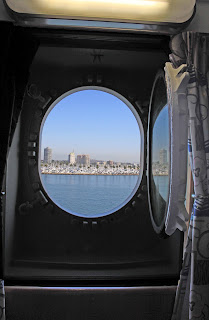It's not just those people who are new to cruising that struggle with the phrases, jargon and acronyms that are used.
So time for a little bit of help, it is nothing to worry about hopefully the list will explain things in plain English. Just read on.
- Aft - Towards the back of the ship.
- Alongside - When the ship is beside the pier (or another ship).
- At Anchor - When the ship is anchored offshore (as opposed to docking alongside).
- Astern - Behind the ship, beyond the stern.
- Balcony - A Balcony space outside, sometime referred to as a Veranda on some Amercian Ships
- Beam - Width of the ship at it's widest point.
- Bearing - Compass direction, expressed in degrees from the ship to a particular destination.
- Berth - The beds in your cabin are sometimes called berths, and when the ship is docked, it's also in a berth.
- Bow - The front of the ship.
- Bridge - As it sounds the place where the Captain steers the ship. If you can get to have a look it's well worth seeing. Why not look at my time on an Inside Access tour with Celebrity.
- Bunkers - Fuel storage area.
- Cabin - What is a 'room' in a hotel is a 'cabin' afloat. Sometimes known as staterooms, your cabin has all the facilities you'd expect from a hotel room.
- Cabin Grade - E1, B3, F5? Confused by all the letters and number combinations, especially as each cruise line has their own code, call me and I can help.
- Cabin steward/stewardess - This is the lovely lady or gent that takes care of your cabin every day, turning it down at night and maybe even leaving a chocolate or towel animal on your pillow.
- Cashless system - No need to carry cash around the ship as your boarding/swipe card can be used to make purchases on board.
- Colours - Ship's emblem or Flag of nationality.
- Crew - All those people on board there to make your holiday extra special. From the Captain to the laundry people, from the wine waiters to the spa therapists.
- Disembarking - Quite simply, this is getting off the boat
- Dock - The act of bringing the ship alongside the Quay.
- Draft - Distance from the ship's waterline to the bottom of it's keel.
- Embarking - Getting on ship.
- Emergency drill - A requirement of maritime law, it is compulsory for guests to attend an emergency drill. The purpose of this is to familiarise you with the safety procedures on board and the actions you must take in the event of a real emergency.
- Forward - Towards to front of the ship.
- Funnel - Ship's exhaust.
- Galley - Ship's kitchen.
- Gangway - The ramp linking the ship to the land.
- G.R.T. - Gross Registered Tonnage. This geeky, but is the ship's total internal volume expressed in "register tons", one of which equals to a volume of 100 cubic feet (2.83 m3). It is calculated from the total permanently enclosed capacity of the vessel. This is basically how big and heavy a ship is.
- Inside Cabin - A cabin situated in the middle of the ship. Ideal if you're happy to go up to the deck for your sea view.
- Keel - Longitudinal extension of the ship's underside.
- Knot - Term for speed at see, 1 nautical mile per hour.
- Life Boat - For use in an emergency.
- Life Jackets - 1 per person can be found in your cabin on arrival. To be used at the emergency drill and in the case of an emergency. There are others on board at strategic points in the ship.
- Midships - Towards the middle of the ship.
- Muster / Muster Station - Assemble guests and/or crew at your emergency assembly point. This is a mandatory requirement and in the first few hours of your cruise, the alarms will go off, you'll don that gorgeously fetching looking life jacket of yours and head to your muster station.
- Nautical mile - 1,852 meters (10 knots = 10 nautical miles per hour = 11.5 land miles per hour)
Outside Cabin - A 'sea view' cabin. Outside cabins means you'll have a window to enjoy the scenery floating by. - Pilot - Independent navigational adviser who comes on board to guide the ship when entering and leaving port.
- Pontoon - Used and lowered to the side of the ship for guests to walk on prior to getting in the tender boat to go ashore when the ship is at anchor.
- Port - Listen up, there are two meanings. Port means the left of the ship. But it also refers to places you'll visit...basically, all those fabulous destinations you'll be visiting on your cruise.
- Porthole - If you've booked an outside cabin, you'll have a window, AKA a porthole.
- Pullman Bed - This is a pull down bed from the wall for some of the beds in the cabins.
- Quay - Dock, pier, or berth.
- Rudder - The bit of the boat that steers it usually but some propulsion systems use a rudderless system.
- Satellite Navigator - The global positioning system (GPS). A system using 24 satellites to fix the ships position.
- Stabilisers - Wing shaped fins on the bottom of the boat that helps minimise the side to side rolling movement. There to make the cruise as as smooth sailing as it possibly can be.
- Starboard - To the right of the ship.
- Stern - The back of the ship.
- Swell - The motion of the ocean.
- Tender - If your ship cannot dock in the port, you will get a tender to the shore, could be the ships lifeboats or tenders from the port.













